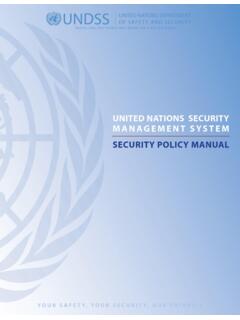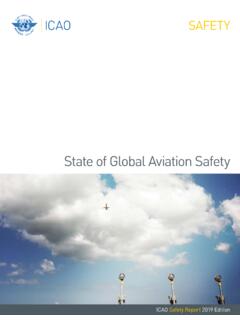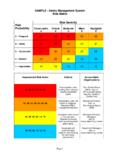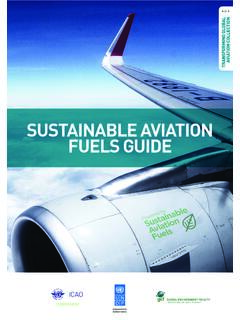Transcription of Unit 2: Health and Safety in the Aviation Industry
1 Health and Safety in the Aviation Industry Pearson BTEC Nationals (QCF) specifi cation in Aviation Operations Issue 2 November 2019 Pearson Education Limited 20121 Unit 2: Health and Safety in the Aviation IndustryUnit code: R/602/5675 QCF Level 3: BTEC NationalCredit value: 7 Guided learning hours: 57 Aim and purposeThe aim of this unit is for learners to gain knowledge and an understanding of Health and Safety within the Aviation Industry to ensure the integrity of fl ight operations, build public confi dence and guarantee future introductionThis unit starts by asking learners to examine accident statistics and the importance of Health and Safety to the Aviation Industry .
2 This sets the scene for introducing the organisations, laws and regulations tasked with keeping the Aviation Industry safe which are numerous and diverse and include the Health and Safety Executive (HSE), the Air Accidents Investigation Branch (AAIB) and the Civil Aviation Authority. Learners do not need to become experts, but should understand the structure of Health and Safety in the Aviation will explore the systems that have been put in place to keep the Industry safe through case studies and real-life situations, for example injuries and fatalities to personnel working on the ramp, Health issues relating to cabin crew on a fl ight. Understanding these situations enables those working in the Industry to put systems in place to deal with a multitude of diff erent, and sometimes unimaginable, scenarios.
3 Learners will look at the procedures for dealing with minor and major events on the ground and in the air. The Aviation Industry has developed emergency plans to deal with disasters; these plans need to be tested and calibrated by everyone concerned. Learners will examine the systems used to monitor, control and improve Health and Safety and learn about the supervisor s responsibility within a Human Factors programme. On completion of the unit learners will appreciate the importance of providing a safe and healthy Aviation outcomesOn completion of this unit a learner should:1 Understand the importance of Health and Safety in the Aviation industry2 Understand how Health and Safety is regulated in the Aviation industry3 Understand how Health and Safety working practices and procedures are implemented in the Aviation industry4 Understand how systems are used to monitor, control and improve Aviation Health and safety5 Understand a supervisor s responsibility within a Human Factors and Safety in the Aviation Industry Pearson BTEC Nationals (QCF)
4 Specifi cation in Aviation Operations Issue 2 November 2019 Pearson Education Limited 20122 Unit content1 Understand the importance of Health and Safety in the Aviation industryAccident statistics: workplace at airports in the airIncidents: Safety , bird strike, foreign object debris (FOD), aircraft fi re, collision between aircraft and airside vehicle, fuel spillage Health , slips, trips, falls, hearing damage, musculoskeletal damageImportance of maintaining a safe environment: to the organisation, licensing, court fi nes, bad publicity, loss of revenue, compliance with Health and Safety regulations to staff , to reduce accidents and injuries, disciplinary action, responsibility in law to visitors and passengers, unfamiliar with their surroundings, unaware of potential dangers2 Understand how Health and Safety is regulated in the Aviation industryCurrent Health and Safety regulations in relation to.
5 Health and Safety at work other relevant Health and Safety legislation and regulations, noise control, control of substances hazardous to Health , working-time regulations, manual handling, data protection, personal protective equipment (PPE) reporting of accidents and serious occurrences at work civil Aviation acts CAA regulations company procedures relating to Health and safetyResponsibilities of supervisors and employees: ensuring staff compliance, wearing PPE, following manual handling regulations, maintaining training records, reporting and investigating incidentsRole of regulatory bodies and organisations involved in Aviation Health and Safety .
6 Regulatory bodies, International Civil Aviation Organization (ICAO), Civil Aviation Authority (CAA), Health and Safety Executive (HSE), Department for Transport (DfT), Air Accidents Investigation Branch (AAIB) Aviation and other organisations, local authority, ambulance, fi re and rescue, police and social services, airports, airlines, handling agents, security companies, cleaning companies, fueling companies3 Health and Safety in the Aviation Industry Pearson BTEC Nationals (QCF) specifi cation in Aviation Operations Issue 2 November 2019 Pearson Education Limited 20123 Understand how Health and Safety working practices and procedures are implemented in the Aviation industryHow to implement safe working practices: risk assessment (method, reasons) staff /union consultation Health and Safety representative using best practice , HSE recommendations following instructions, from equipment manufacturer following standard operating procedures (SOPs), company SOPsImplementation of procedures relating to minor Health and Safety incidents.
7 Actions, isolate incident site, protect ground staff /air crew/passengers from further risk, follow standard response procedures (ground and air), report all incidents in a timely manner, keep a record of actions taken (internally or to HSE/CAA/DfT), take photographs where possible, investigate circumstances, interview ground staff /air crew concerned, take remedial action type of minor incident, slip, trip, fall, collision, illness on board aircraft personnel involved, cabin crew, security , police, fi rst aiders, ambulance, fi re and rescueImplementation of procedures relating to major emergencies: actions, as for minor incidents plus follow emergency orders, cordon off incident site, protect evidence, cooperate with emergency services, protect own staff from harm, inform CAA/DfT/AAIB as appropriate type of emergency situation, aircraft accident, serious injury, fatality, suspected communicable disease on inbound fl ight personnel, air crew, security , police, fi rst aiders, ambulance, fi re and rescue4 Understand how systems are used to monitor, control and improve Aviation Health and safetySystems used to monitor, control and improve Health and Safety .
8 Monitor, routine staff reports, routine inspections, unannounced inspections (in-house, regulators), audits, risk assessment reviews, airport Safety committee, fl ight briefi ngs control, HSE regulations, CAA regulations, local airport regulations, training, testing personnel, minimum Safety standards (vehicles, equipment), designated Health and Safety offi cer, enforced standard operating procedures improve, mandatory actions (imposed by HSE, CAA, airport authority), learning from previous accidents, sharing information (within airport and globally), incident response training exercisesHealth and Safety in the Aviation Industry Pearson BTEC Nationals (QCF) specifi cation in Aviation Operations Issue 2 November 2019 Pearson Education Limited 20124 Implementation of systems to monitor, control and improve Health and Safety .
9 Interpretation of regulations, from ICAO, CAA, HSA, DfT, JAR OPS designated trainers and compulsory training, recurrent SEP training for cabin crew issuing of licences maintain clear training records maintain records of inspections (audit trail) involvement of all agencies in emergency planning5 Understand a supervisor s responsibility within a Human Factors programmeSupervisor responsibility: to self to others to organisationHuman Factors programme: training requirements reporting procedures injury prevention procedures management of fatigue/alertness awareness auditing and assessment requirements5 Health and Safety in the Aviation Industry Pearson BTEC Nationals (QCF) specifi cation in Aviation Operations Issue 2 November 2019 Pearson Education Limited 2012 Assessment and grading criteriaIn order to pass this unit, the evidence that the learner presents for assessment needs to demonstrate that they can meet all the learning outcomes for the unit.
10 The assessment criteria for a pass grade describe the level of achievement required to pass this and grading criteriaTo achieve a pass grade the evidence must show that the learner is able to:To achieve a merit grade the evidence must show that, in addition to the pass criteria, the learner is able to:To achieve a distinction grade the evidence must show that, in addition to the pass and merit criteria, the learner is able to:P1 Describe diff erent types of Health and Safety accidents or incidents that can occur relating to aircraft, other airside and landside hazards [IE]M1 Analyse the cause of Health and Safety accidents or incidents D1 Discuss the involvement of Health and Safety organisations, regulatory bodies, systems and procedures prior to.

















